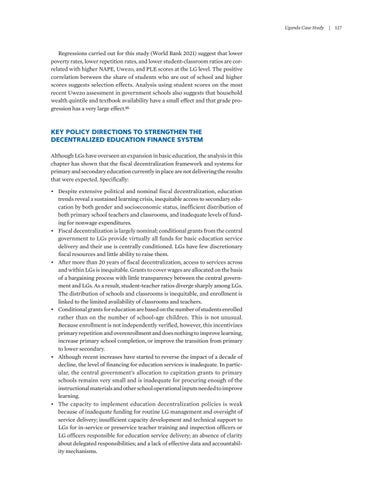Uganda Case Study | 127
Regressions carried out for this study (World Bank 2021) suggest that lower poverty rates, lower repetition rates, and lower student-classroom ratios are correlated with higher NAPE, Uwezo, and PLE scores at the LG level. The positive correlation between the share of students who are out of school and higher scores suggests selection effects. Analysis using student scores on the most recent Uwezo assessment in government schools also suggests that household wealth quintile and textbook availability have a small effect and that grade progression has a very large effect.69
KEY POLICY DIRECTIONS TO STRENGTHEN THE DECENTRALIZED EDUCATION FINANCE SYSTEM Although LGs have overseen an expansion in basic education, the analysis in this chapter has shown that the fiscal decentralization framework and systems for primary and secondary education currently in place are not delivering the results that were expected. Specifically: • Despite extensive political and nominal fiscal decentralization, education trends reveal a sustained learning crisis, inequitable access to secondary education by both gender and socioeconomic status, inefficient distribution of both primary school teachers and classrooms, and inadequate levels of funding for nonwage expenditures. • Fiscal decentralization is largely nominal; conditional grants from the central government to LGs provide virtually all funds for basic education service delivery and their use is centrally conditioned. LGs have few discretionary fiscal resources and little ability to raise them. • After more than 20 years of fiscal decentralization, access to services across and within LGs is inequitable. Grants to cover wages are allocated on the basis of a bargaining process with little transparency between the central government and LGs. As a result, student-teacher ratios diverge sharply among LGs. The distribution of schools and classrooms is inequitable, and enrollment is linked to the limited availability of classrooms and teachers. • Conditional grants for education are based on the number of students enrolled rather than on the number of school-age children. This is not unusual. Because enrollment is not independently verified, however, this incentivizes primary repetition and overenrollment and does nothing to improve learning, increase primary school completion, or improve the transition from primary to lower secondary. • Although recent increases have started to reverse the impact of a decade of decline, the level of financing for education services is inadequate. In particular, the central government’s allocation to capitation grants to primary schools remains very small and is inadequate for procuring enough of the instructional materials and other school operational inputs needed to improve learning. • The capacity to implement education decentralization policies is weak because of inadequate funding for routine LG management and oversight of service delivery; insufficient capacity development and technical support to LGs for in-service or preservice teacher training and inspection officers or LG officers responsible for education service delivery; an absence of clarity about delegated responsibilities; and a lack of effective data and accountability mechanisms.






